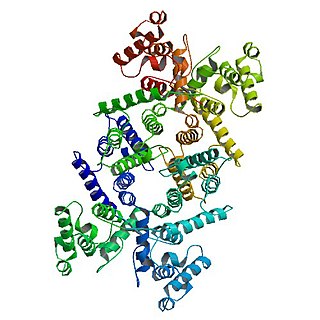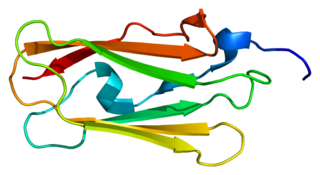Delta-sarcoglycan is a protein that in humans is encoded by the SGCD gene. [5] [6] [7] [8]
Delta-sarcoglycan is a protein that in humans is encoded by the SGCD gene. [5] [6] [7] [8]
The protein encoded by this gene is one of the four known components of the sarcoglycan complex, which is a subcomplex of the dystrophin-glycoprotein complex (DGC). DGC forms a link between the F-actin cytoskeleton and the extracellular matrix. This protein is expressed most abundantly in skeletal and cardiac muscle. The mutations in this gene have been associated with autosomal recessive limb-girdle muscular dystrophy and dilated cardiomyopathy. Alternatively spliced transcript variants encoding distinct isoforms have been observed. [8]
In melanocytic cells SGCD gene expression may be regulated by MITF. [9]

Limb–girdle muscular dystrophy or (LGMD) is a genetically and clinically heterogeneous group of rare muscular dystrophies. It is characterised by progressive muscle wasting which affects predominantly hip and shoulder muscles. LGMD has an autosomal pattern of inheritance and currently has no known cure or treatment.

Dystrophin is a rod-shaped cytoplasmic protein, and a vital part of a protein complex that connects the cytoskeleton of a muscle fiber to the surrounding extracellular matrix through the cell membrane. This complex is variously known as the costamere or the dystrophin-associated protein complex (DAPC). Many muscle proteins, such as α-dystrobrevin, syncoilin, synemin, sarcoglycan, dystroglycan, and sarcospan, colocalize with dystrophin at the costamere.
Derek Blake was, until 2007, the Isobel Laing Post-Doctoral Fellow in Biomedical Sciences, and the Wellcome Trust Senior Fellow in Basic Biomedical Science, Oriel College, Oxford.

Dysferlin also known as dystrophy-associated fer-1-like protein is a protein that in humans is encoded by the DYSF gene.
The sarcoglycanopathies are a collection of diseases resulting from mutations in any of the five sarcoglycan genes: α, β, γ, δ or ε. The five sarcoglycanopathies are: α-sarcoglycanopathy, LGMD2D; β-sarcoglycanopathy, LGMD2E; γ-sarcoglycanopathy, LGMD2C; δ-sarcoglycanopathy, LGMD2F and ε-sarcoglycanopathy, myoclonic dystonia. The four different sarcoglycan genes encode proteins that form a tetrameric complex at the muscle cell plasma membrane. This complex stabilizes the association of dystrophin with the dystroglycans and contributes to the stability of the plasma membrane cytoskeleton. The four sarcoglycan genes are related to each other structurally and functionally, but each has a distinct chromosome location.
The sarcoglycans are a family of transmembrane proteins involved in the protein complex responsible for connecting the muscle fibre cytoskeleton to the extracellular matrix, preventing damage to the muscle fibre sarcolemma through shearing forces.

Utrophin is a protein that in humans is encoded by the UTRN gene.

Fukutin is a eukaryotic protein necessary for the maintenance of muscle integrity, cortical histogenesis, and normal ocular development. Mutations in the fukutin gene have been shown to result in Fukuyama congenital muscular dystrophy (FCMD) characterised by brain malformation - one of the most common autosomal-recessive disorders in Japan. In humans this protein is encoded by the FCMD gene, located on chromosome 9q31. Human fukutin exhibits a length of 461 amino acids and a predicted molecular mass of 53.7 kDa.

Calpain-3 is a protein that in humans is encoded by the CAPN3 gene.

Filamin-C (FLN-C) also known as actin-binding-like protein (ABPL) or filamin-2 (FLN2) is a protein that in humans is encoded by the FLNC gene. Filamin-C is mainly expressed in cardiac and skeletal muscles, and functions at Z-discs and in subsarcolemmal regions.

Beta-sarcoglycan is a protein that in humans is encoded by the SGCB gene.

Epsilon-sarcoglycan is a protein that in humans is encoded by the SGCE gene.

Alpha-sarcoglycan is a protein that in humans is encoded by the SGCA gene.

Myotilin is a protein that in humans is encoded by the MYOT gene. Myotilin also known as TTID is a muscle protein that is found within the Z-disc of sarcomeres.

Gamma-sarcoglycan is a protein that in humans is encoded by the SGCG gene. The α to δ-sarcoglycans are expressed predominantly (β) or exclusively in striated muscle. A mutation in any of the sarcoglycan genes may lead to a secondary deficiency of the other sarcoglycan proteins, presumably due to destabilisation of the sarcoglycan complex. The disease-causing mutations in the α to δ genes cause disruptions within the dystrophin-associated protein (DAP) complex in the muscle cell membrane. The transmembrane components of the DAP complex link the cytoskeleton to the extracellular matrix in adult muscle fibres, and are essential for the preservation of the integrity of the muscle cell membrane.

Beta-1-syntrophin is a protein that in humans is encoded by the SNTB1 gene.

Dystrobrevin alpha is a protein that in humans is encoded by the DTNA gene.

Beta dystrobrevin also known as DTNB is a protein which in humans is encoded by the DTNB gene.

Sarcoglycan zeta also known as SGCZ is a protein which in humans is encoded by the SGCZ gene.

In molecular biology, the CD20-like family of proteins includes the CD20 protein and the beta subunit of the high affinity receptor for IgE Fc, MS4A2. MS4A2 has a tetrameric structure consisting of a single IgE-binding alpha subunit, a single beta subunit, and two disulfide-linked gamma subunits. It has four putative transmembrane segments and a probable topology where both amino- and carboxy termini protrude into the cytoplasm. This family also includes LR8 like proteins from humans (TMEM176B), mice and rats. The function of the human LR8 protein is unknown although it is known to be strongly expressed in the lung fibroblasts. This family also includes sarcospan, a transmembrane component of dystrophin-associated glycoprotein. Loss of the sarcoglycan complex and sarcospan alone is sufficient to cause muscular dystrophy. The role of the sarcoglycan complex and sarcospan is thought to be to strengthen the dystrophin axis connecting the basement membrane with the cytoskeleton.